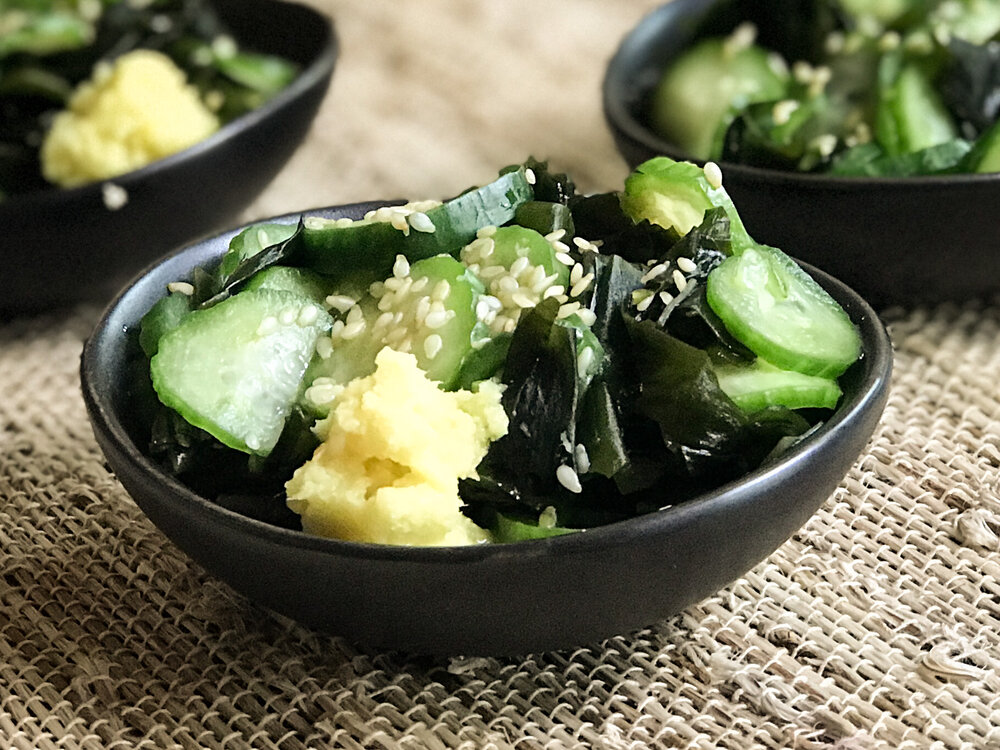Cucumber Sunomono
This light, refreshing cucumber salad is lovely on its own; you can also toss it with cooked shrimp or crab or sashimi, or top it with fish roe, such as masago, tobiko or ikura. It’s adapted from Sonoko Sakai’s Japanese Home Cooking: Simple Meals, Authentic Flavors, which we reviewed in June 2020. We like Sakai’s version because unlike with many sunomonos, her sanbaizu dressing does not include sugar. Sakai explains in her headnote that sanbaizu means “three cups” — named for its three ingredients: vinegar, mirin and soy sauce, which traditionally are used in equal parts. "Today the ratio varies,” she writes. “People use less soy sauce and some people use cane sugar instead of mirin for a sweeter taste.”
The grated ginger garnish adds complexity and bright dimension, but it is also delicious without it.
To toast sesame seeds, heat a small dry skillet on medium heat, add the sesame seeds and toast, stirring frequently, just until they’re fragrant and start to turn golden. Traditionally a Japanese grater called an oroshi-ki is used to grate ginger, but a fine Microplane grater works too.
Makes 4 servings.
Ingredients
For the sanbaizu dressing
1/4 cup mirin
1/4 cup rice vinegar
2 tablespoons usukuchi shoyu (Japanese light-colored soy sauce) or dark soy sauce
For the salad
1/3 cup (7.5 g) dried wakame seaweed
3 Persian cucumber or 1 1/2 Japanese cucumbers, sliced crosswise into 1/8-inch rounds
3/4 teaspoon sea salt
3/4 teaspoon toasted white sesame seeds
1 teaspoon grated ginger (optional garnish)
Instructions
1. To make the sanbaizu dressing, combine the mirin and vinegar in a small saucepan over low heat and bring to a boil. Remove from heat, add the soy sauce and let cool. You can make the dressing in advance; it will keep in the refrigerator for 3 to 4 days.
2. Place the wakame in a small bowl, pour nearly boiling water over it to cover generously, and let it rehydrate for 10 minutes. Drain, cut into bite-sized pieces and set aside.
3. While the wakame is rehydrating, place the cucumbers in a bowl, sprinkle with the salt and massage the salt gently into the cucumber slices with your fingers for about 1 minute. Let them stand for 5 minutes, then squeeze out and pour away the extra water.
4. Pour 1/4 cup of the dressing onto the cucumbers, toss well, gently squeeze out the extra dressing with your hand and drain off the extra dressing. Add the wakame and the remaining dressing and toss gently. Divide the salad into four small serving dishes and garnish with the sesame seeds and (if using) grated ginger.
Recipe notes
• The original version in the book includes glass noodles (harusame). We tested it that way as well, and liked it, but didn’t feel it brought enough to the dish to justify the extra step. (If you’d like to add it back in, boil 1 1/2 ounces of dried glass noodles in water until just tender, about 2 minutes, drain, and cut into 3-inch pieces. Add them to the salad when you add the wakame.)
• We upped the amounts of the salad ingredients by 50%, as the Sakai’s recipe made more than enough dressing for the two Persian cucumbers and quarter-cup of wakame she called for — and the salad was so delightful we wanted slightly larger portions. (They’re still pretty dainty.)
• Sakai’s recipe calls specifically for usukuchi shoyo (light-colored soy sauce), which is what we used when testing the recipe. However, the ingredient is not easy to find, unless you have access to a Japanese supermarket. Other recipes for sanbaizu dressing — such as the one in Shizuo Tsuji’s seminal Japanese Cooking: A Simple Art — call for light or dark soy, so we broadened the requirement.

Cucumber Sunomono
Ingredients
- 1/4 cup mirin
- 1/4 cup rice vinegar
- 2 tablespoons usukuchi shoyu (Japanese light-colored soy sauce) or dark soy sauce
- 1/3 cup (7.5 g) dried wakame seaweed
- 3 Persian cucumber or 1 1/2 Japanese cucumbers, sliced crosswise into 1/8-inch rounds
- 3/4 teaspoon sea salt
- 3/4 teaspoon toasted white sesame seeds
- 1 teaspoon grated ginger (optional garnish)
Instructions
- To make the sanbaizu dressing, combine the mirin and vinegar in a small saucepan over low heat and bring to a boil. Remove from heat, add the soy sauce and let cool. You can make the dressing in advance; it will keep in the refrigerator for 3 to 4 days.
- Place the wakame in a small bowl, pour nearly boiling water over it to cover generously, and let it rehydrate for 10 minutes. Drain, cut into bite-sized pieces and set aside.
- While the wakame is rehydrating, place the cucumbers in a bowl, sprinkle with the salt and massage the salt gently into the cucumber slices with your fingers for about 1 minute. Let them stand for 5 minutes, then squeeze out and pour away the extra water.
- Pour 1/4 cup of the dressing onto the cucumbers, toss well, gently squeeze out the extra dressing with your hand and drain off the extra dressing. Add the wakame and the remaining dressing and toss gently. Divide the salad into four small serving dishes and garnish with the sesame seeds and (if using) grated ginger.




